Abstract
Fifteen patients who had had a myocardial infarction before the age of 43 were compared with thirteen age-matched normal subjects. Twelve of the patients and three of the controls had a delayed glucose and insulin peak in the glucose and insulin areas than normal curves. When the measurements of the four patients with the largest areas under the glucose tolerance curve were separated, significant correlations were observed in the remaining patients and controls. The ratio in serum of the concentrations of estradiol-17beta to testosterone (E/T) correlated with serum glucose area (r equals + 0.69, P is less than 0.001), insulin area (r equals + 0.80, P is less than 0.001), and the ratio of insulin area to glucose area (I/G) (r equals + 0.64, P is less than 0.005) in the glucose tolerance test. Serum cholesterol concentration correlated with E/T, insulin area, and I/G, and serum triglyceride concentration correlated with glucose area, I/G, and serum cholesterol concentration. The hypothesis is presented (i) that in men who have had a myocardial infarction, an abnormality in glucose tolerance and insulin response and elevation in serum cholesterol and triglyceride concentrations are all part of the same defect (glucose-insulin-lipid defect), (ii) that this glucose-insulin-lipid defect when glucose intolerance is present is the "mild diabetes" commonly associated with myocardial infarction but is based on a mechanism different from that of classical diabetes, (iii) that this glucose-insulin-lipid defect is secondary to an elevation in E/T, and (iv) that an alteration in the sex hormone milieu is the major predisposing factor for myocardial infarction.
Full text
PDF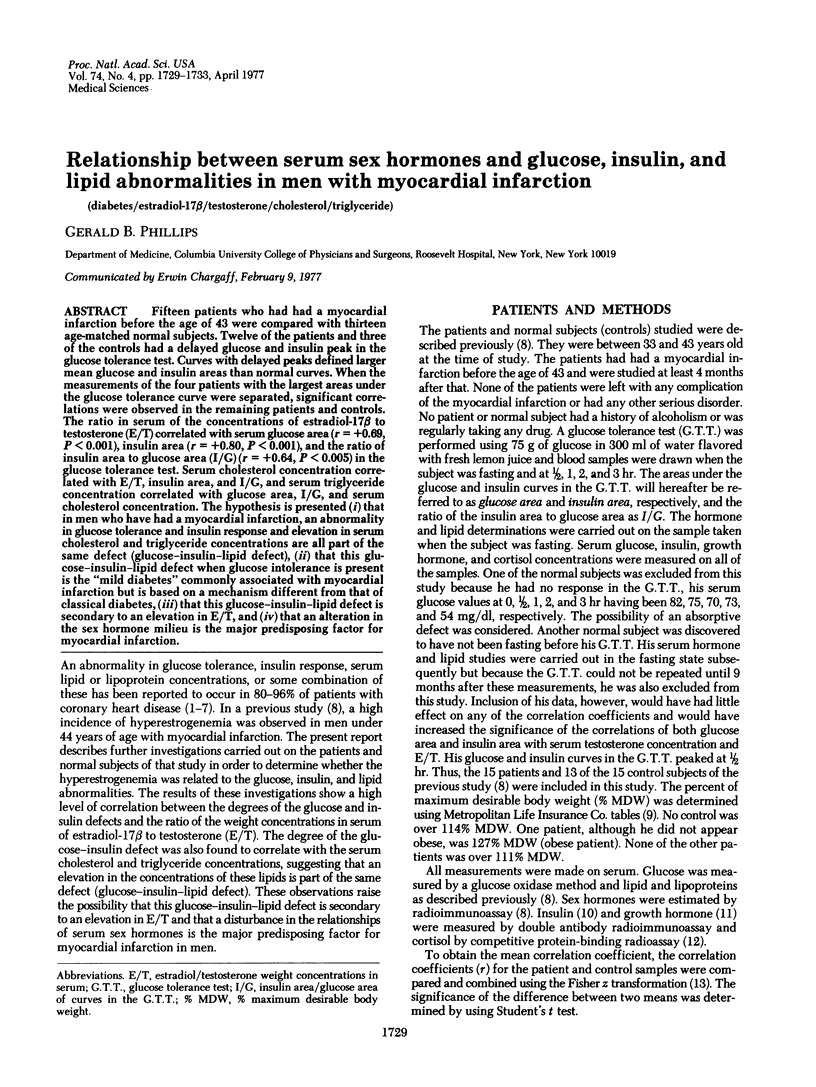
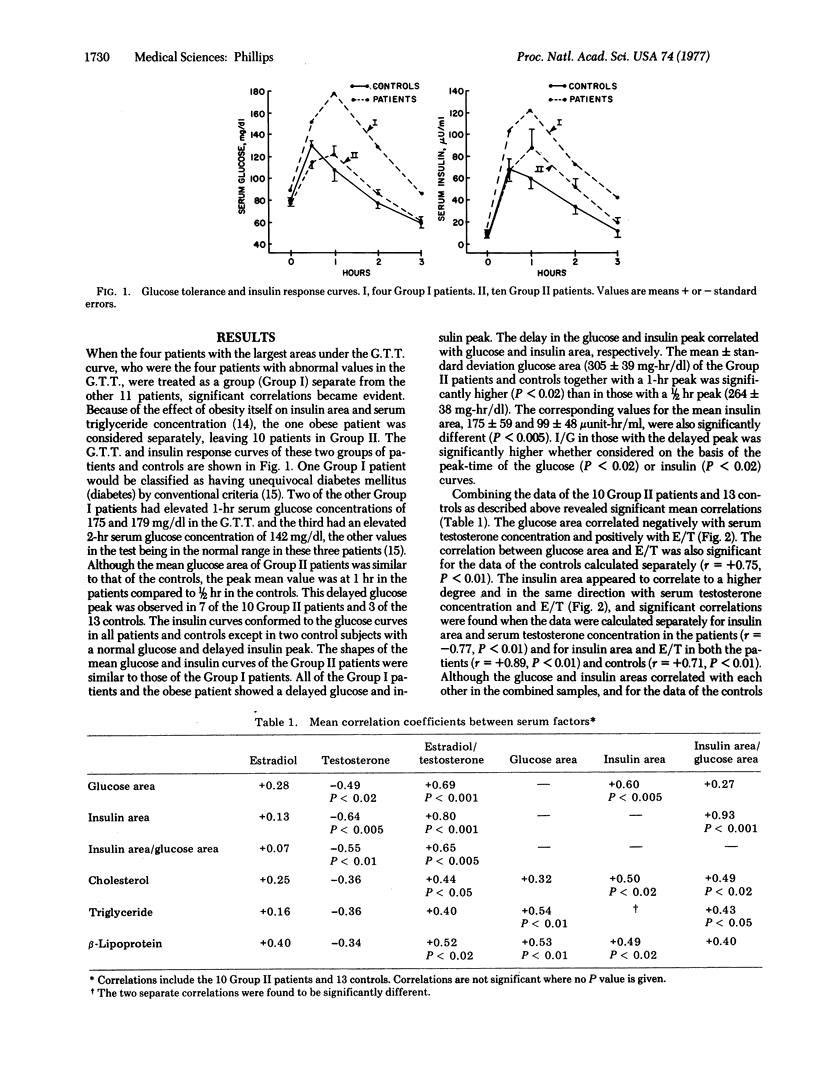
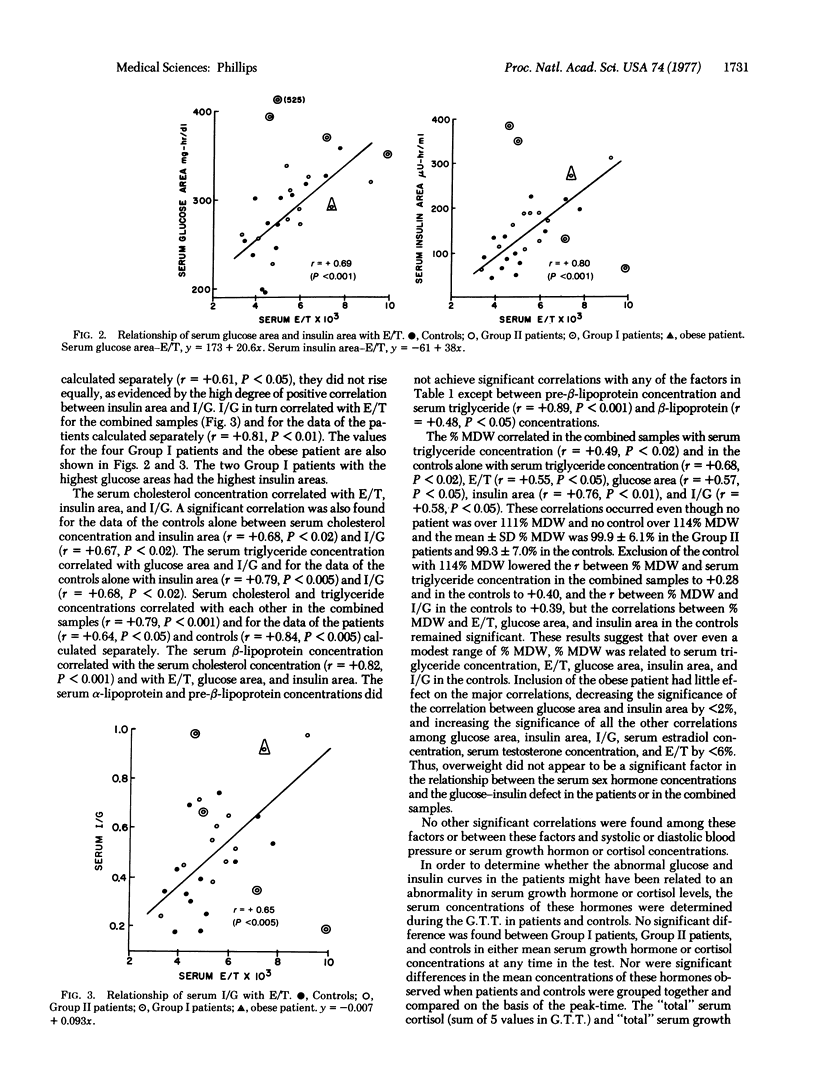
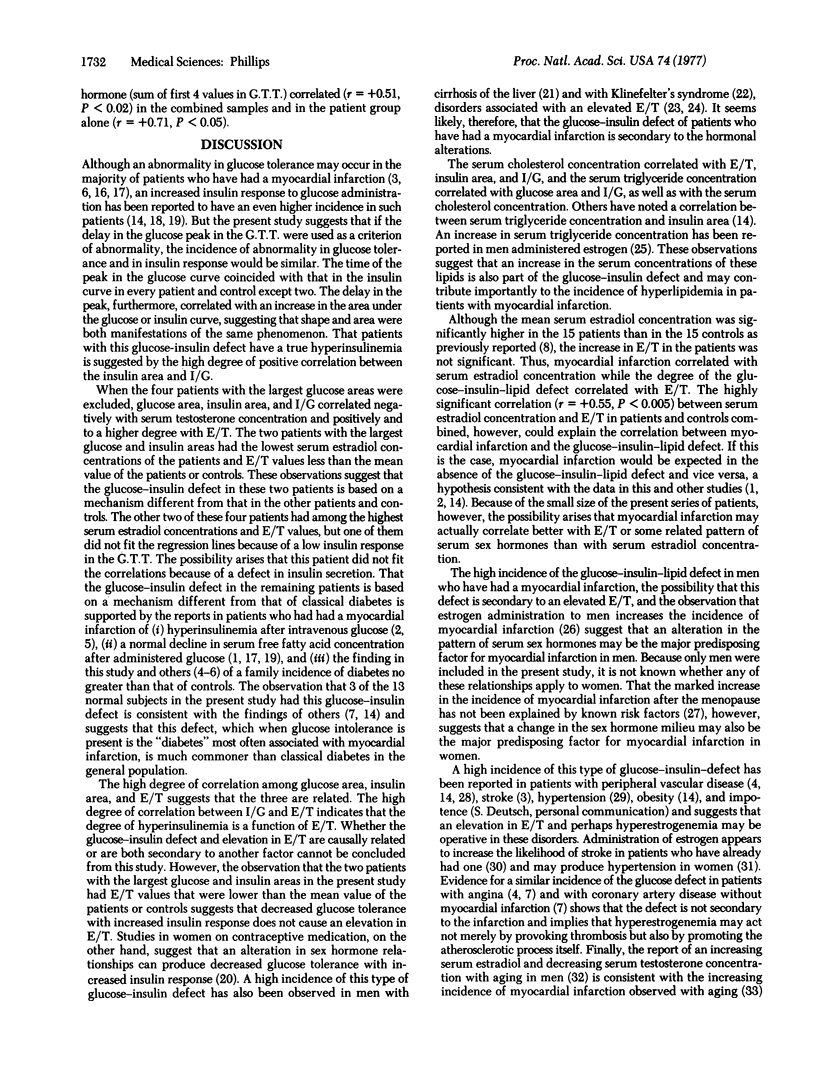
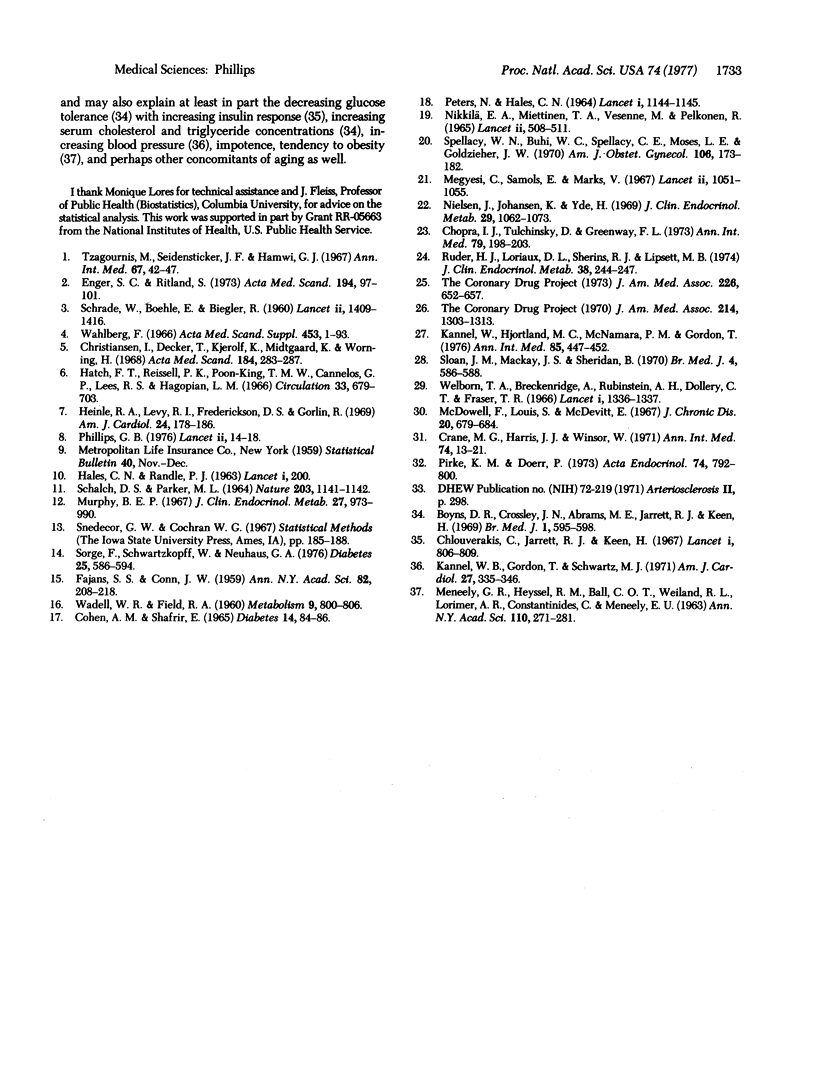
Selected References
These references are in PubMed. This may not be the complete list of references from this article.
- Boyns D. R., Crossley J. N., Abrams M. E., Jarrett R. J., Keen H. Oral glucose tolerance and related factors in a normal population sample. I. Blood sugar, plasma insulin, glyceride, and cholesterol measurements and the effects of age and sex. Br Med J. 1969 Mar 8;1(5644):595–598. doi: 10.1136/bmj.1.5644.595. [DOI] [PMC free article] [PubMed] [Google Scholar]
- COHEN A. M., SHAFRIR E. CARBOHYDRATE METABOLISM IN MYOCARDIAL INFARCTION: BEHAVIOR OF BLOOD GLUCOSE AND FREE FATTY ACIDS AFTER GLUCOSE LOADING. Diabetes. 1965 Feb;14:84–86. doi: 10.2337/diab.14.2.84. [DOI] [PubMed] [Google Scholar]
- Chlouverakis C., Jarrett R. J., Keen H. Glucose tolerance, age, and circulating insulin. Lancet. 1967 Apr 15;1(7494):806–809. doi: 10.1016/s0140-6736(67)92774-2. [DOI] [PubMed] [Google Scholar]
- Chopra I. J., Tulchinsky D., Greenway F. L. Estrogen-androgen imbalance in hepatic cirrhosis. Studies in 13 male patients. Ann Intern Med. 1973 Aug;79(2):198–203. doi: 10.7326/0003-4819-79-2-198. [DOI] [PubMed] [Google Scholar]
- Christiansen I., Deckert T., Kjerulf K., Midtgaard K., Worning H. Glucose tolerance, plasma lipids and serum insulin in patients with ischaemic heart diseases. Acta Med Scand. 1968 Oct;184(4):283–287. doi: 10.1111/j.0954-6820.1968.tb02458.x. [DOI] [PubMed] [Google Scholar]
- Crane M. G., Harris J. J., Winsor W., 3rd Hypertension, oral contraceptive agents, and conjugated estrogens. Ann Intern Med. 1971 Jan;74(1):13–21. doi: 10.7326/0003-4819-74-1-13. [DOI] [PubMed] [Google Scholar]
- Enger S. C., Ritland S. Glucose tolerance, insulin release and lipoprotein pattern in patients after myocardial infarction. Acta Med Scand. 1973 Jul-Aug;1-2(1):97–101. [PubMed] [Google Scholar]
- FAJANS S. S., CONN J. W. The early recognition of diabetes mellitus. Ann N Y Acad Sci. 1959 Sep 25;82:208–218. doi: 10.1111/j.1749-6632.1959.tb44901.x. [DOI] [PubMed] [Google Scholar]
- HALES C. N., RANDLE P. J. Immunoassay of insulin with insulin antibody preciptate. Lancet. 1963 Jan 26;1(7274):200–200. doi: 10.1016/s0140-6736(63)91215-7. [DOI] [PubMed] [Google Scholar]
- Heinle R. A., Levy R. I., Frederickson D. S., Gorlin R. Lipid and carbohydrate abnormalities in patients with angiographically documented coronary artery disease. Am J Cardiol. 1969 Aug;24(2):178–186. doi: 10.1016/0002-9149(69)90401-9. [DOI] [PubMed] [Google Scholar]
- Kannel W. B., Gordon T., Schwartz M. J. Systolic versus diastolic blood pressure and risk of coronary heart disease. The Framingham study. Am J Cardiol. 1971 Apr;27(4):335–346. doi: 10.1016/0002-9149(71)90428-0. [DOI] [PubMed] [Google Scholar]
- Kannel W. B., Hjortland M. C., McNamara P. M., Gordon T. Menopause and risk of cardiovascular disease: the Framingham study. Ann Intern Med. 1976 Oct;85(4):447–452. doi: 10.7326/0003-4819-85-4-447. [DOI] [PubMed] [Google Scholar]
- MENEELY G. R., HEYSSEL R. M., BALL C. O., WEILAND R. L., LORIMER A. R., CONSTANTINIDES C., MENEELY E. U. ANALYSIS OF FACTORS AFFECTING BODY COMPOSITION DETERMINED FROM POTASSIUM CONTENT IN 915 NORMAL SUBJECTS. Ann N Y Acad Sci. 1963 Sep 26;110:271–281. doi: 10.1111/j.1749-6632.1963.tb17092.x. [DOI] [PubMed] [Google Scholar]
- Megyesi C., Samols E., Marks V. Glucose tolerance and diabetes in chronic liver disease. Lancet. 1967 Nov 18;2(7525):1051–1056. doi: 10.1016/s0140-6736(67)90334-0. [DOI] [PubMed] [Google Scholar]
- Murphy B. E. Some studies of the protein-binding of steroids and their application to the routine micro and ultramicro measurement of various steroids in body fluids by competitive protein-binding radioassay. J Clin Endocrinol Metab. 1967 Jul;27(7):973–990. doi: 10.1210/jcem-27-7-973. [DOI] [PubMed] [Google Scholar]
- Nielsen J., Johansen K., Yde H. Frequency of diabetes mellitus in patients with Klinefelter's syndrome of different chromosome constitutions and the XYY syndrome. Plasma insulin and growth hormone level after a glucose load. J Clin Endocrinol Metab. 1969 Aug;29(8):1062–1073. doi: 10.1210/jcem-29-8-1062. [DOI] [PubMed] [Google Scholar]
- Nikkilä E. A., Miettinen T. A., Vesenne M. R., Pelkonen R. Plasma-insulin in coronary heart-disease: response to oral and intravenous glucose and to tolbutamide. Lancet. 1965 Sep 11;2(7411):508–511. doi: 10.1016/s0140-6736(65)91471-6. [DOI] [PubMed] [Google Scholar]
- Phillips G. B. Evidence for hyperoestrogenaemia as a risk factor for myocardial infarction in men. Lancet. 1976 Jul 3;2(7975):14–18. doi: 10.1016/s0140-6736(76)92968-8. [DOI] [PubMed] [Google Scholar]
- Pirke K. M., Doerr P. Age related changes and interrelationships between plasma testosterone, oestradiol and testosterone-binding globulin in normal adult males. Acta Endocrinol (Copenh) 1973 Dec;74(4):792–800. doi: 10.1530/acta.0.0740792. [DOI] [PubMed] [Google Scholar]
- Ruder H. J., Loriaux D. L., Sherins R. J., Lipsett M. B. Leydig cell function in men with disorders of spermatogenesis. J Clin Endocrinol Metab. 1974 Feb;38(2):244–247. doi: 10.1210/jcem-38-2-244. [DOI] [PubMed] [Google Scholar]
- SCHALCH D. S., PARKER M. L. A SENSITIVE DOUBLE ANTIBODY IMMUNOASSAY FOR HUMAN GROWTH HORMONE IN PLASMA. Nature. 1964 Sep 12;203:1141–1142. doi: 10.1038/2031141a0. [DOI] [PubMed] [Google Scholar]
- SCHRADE W., BOEHLE E., BIEGLER R. Humoral changes in arteriosclerosis. Investigations on lipids, fatty acids, ketone bodies, pyruvic acid, lactic acid, and glucose in the blood. Lancet. 1960 Dec 31;2(7166):1409–1416. doi: 10.1016/s0140-6736(60)92565-4. [DOI] [PubMed] [Google Scholar]
- Sloan J. M., Mackay J. S., Sheridan B. Glucose tolerance and insulin response in atherosclerosis. Br Med J. 1970 Dec 5;4(5735):586–588. doi: 10.1136/bmj.4.5735.586. [DOI] [PMC free article] [PubMed] [Google Scholar]
- Sorge F., Schwartzkopff W., Neuhaus G. A. Insulin response to oral glucose in patients with a previous myocardial infarction and in patients with peripheral vascular disease. Hyperinsulinism and its relationships to hypertriglyceridemia and overweight. Diabetes. 1976 Jul;25(7):586–594. doi: 10.2337/diab.25.7.586. [DOI] [PubMed] [Google Scholar]
- Spellacy W. N., Buhi W. C., Spellacy C. E., Moses L. E., Goldzieher J. W. Glucose, insulin, and growth hormone studies in long-term users of oral contraceptives. Am J Obstet Gynecol. 1970 Jan 15;106(2):173–182. doi: 10.1016/0002-9378(70)90259-0. [DOI] [PubMed] [Google Scholar]
- Tzagournis M., Seidensticker J. F., Hamwi G. J. Serum insulin, carbohydrate, and lipid abnormalities in patients with premature coronary heart disease. Ann Intern Med. 1967 Jul;67(1):42–47. doi: 10.7326/0003-4819-67-1-42. [DOI] [PubMed] [Google Scholar]
- Welborn T. A., Breckenridge A., Rubinstein A. H., Dollery C. T., Fraser T. R. Serum-insulin in essential hypertension and in peripheral vascular disease. Lancet. 1966 Jun 18;1(7451):1336–1337. doi: 10.1016/s0140-6736(66)92132-5. [DOI] [PubMed] [Google Scholar]


